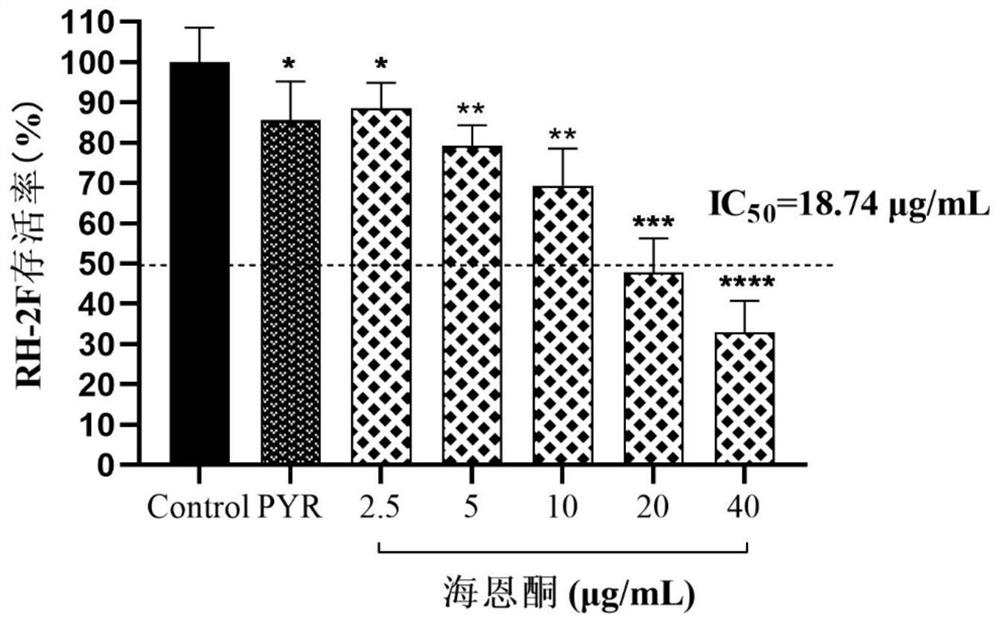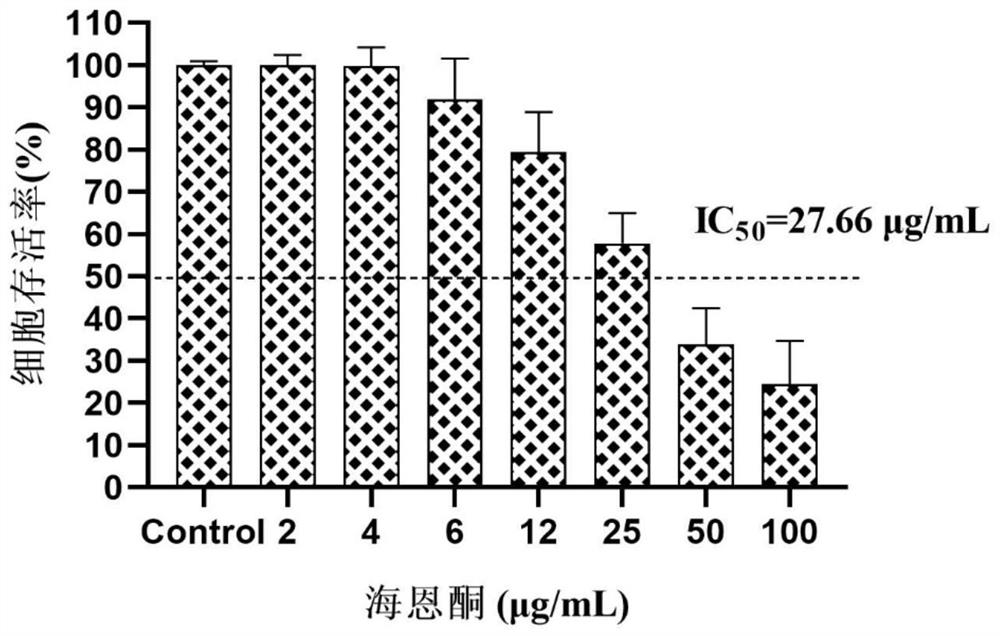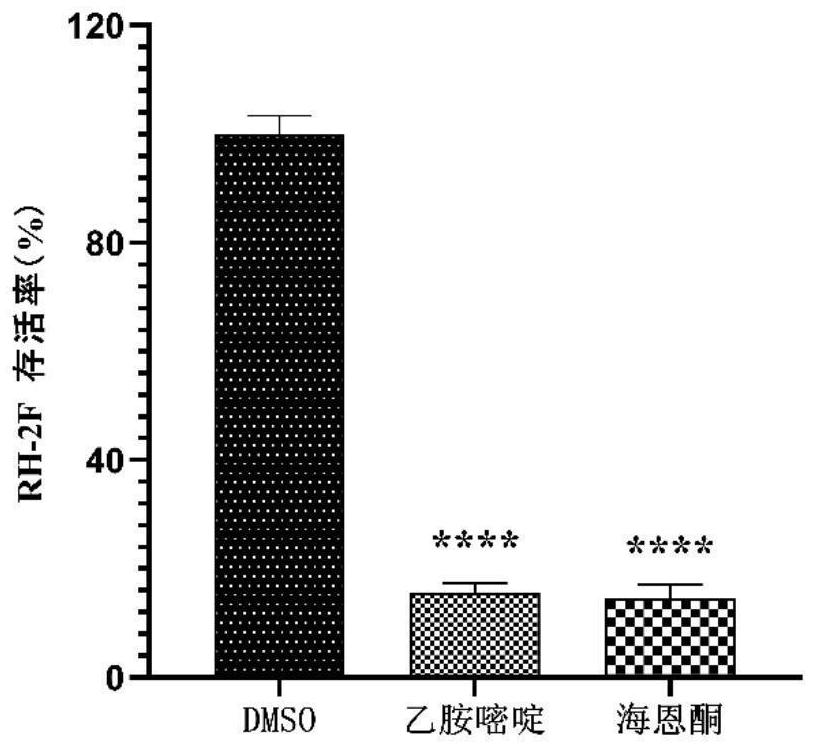Application of hycanthone in preparation of medicine for treating toxoplasma gondii infection diseases
A technology for infecting diseases and toxoplasma, which is applied in the field of parasitic disease control and toxoplasma control, and can solve problems such as difficult removal and damage to host cells
- Summary
- Abstract
- Description
- Claims
- Application Information
AI Technical Summary
Problems solved by technology
Method used
Image
Examples
Embodiment 1
[0026] Example 1 Determination of the inhibitory effect of hyenone on extracellular RH-2F tachyzoites by biochemiluminescence
[0027] Steps: Toxoplasma gondii type I virulent strain RH-2F expressing β-galactosidase was selected for growth inhibition assay. Harvest fresh and vigorous RH-2F tachyzoites from Vero cells, count on a hemocytometer, and adjust the concentration of RH-2F to 1×10 5 individual / mL. Various concentrations of hyenone were prepared in this way, and added to a white 96-well plate, with 0.25% DMSO as the control group, 10 μg / mL pyrimethamine as the positive control, and the medium only as the blank group. Add Beta- As for the detection reagent, after 30 minutes of action, the luminescence value was detected in a photometer to calculate the survival rate of RH-2F.
[0028] Result: results like figure 1 , IC of Hyenone against Toxoplasma gondii 50 The inhibitory effect on Toxoplasma gondii was dose-dependent, and the higher the concentration, the stronge...
Embodiment 2
[0029] The cytotoxicity of embodiment 2 hyenone to Vero cell
[0030] Steps: CCK-8 method was used to determine the toxicity of hyenone to Vero cells. Vero cells 1 x 10 5 cells / mL, inoculated in 96-well plate, and after culturing for 12 hours, various concentrations of compounds were added. The wells without compound were used as the control group, and the wells containing only the medium were used as the blank group. After culturing for 24 hours, add CCK-8 reagent, measure the OD value of each well in a microplate reader after 1-2 hours of action, calculate the cell survival rate according to the following formula, and repeat the independent experiment 3 times.
[0031] Cell viability (%) = (OD 实验组 -OD 空白组 ) / (OD 对照组 -OD 空白组 )×100%
[0032] Results: IC of Hyenone on African green monkey kidney cells 50 It was 27.66μg / mL, and it was dose-dependent. When the concentration was 100μg / mL, the cell survival rate was 24.53%, and when it was 50μg / mL, it was 33.87%. At 4 μg / mL...
Embodiment 3
[0033] Example 3 Determination of the antiproliferative effect of hyenone on intracellular RH-2F by biochemiluminescence
[0034] Steps: Put 1×10 5 RH-2F tachyzoites / mL were inoculated in a 96-well plate of monolayer Vero cells. After 2 hours of invasion, the non-invading tachyzoites were removed with Duchenne's phosphate buffered saline (DPBS), and seawater at a concentration of 4 μg / mL was added. enone, negative control group (0.25% DMSO) and positive control group (10 μg / mL pyrimethamine) were set at the same time. After 24 hours, add Glo Lysis Buffer to lyse the cells, then add Beta- The detection reagent measures the luminescence value and calculates the survival rate of RH-2F.
[0035]Result: The survival rate of RH-2F tachyzoites in the negative control group was recorded as 100%, and the RH-2F survival rate of hyinone and pyrimethamine was calculated, and the survival rate of positive control pyrimethamine was 15.54%. The survival rate was 14.57%. The results show...
PUM
| Property | Measurement | Unit |
|---|---|---|
| Cell viability | aaaaa | aaaaa |
Abstract
Description
Claims
Application Information
 Login to View More
Login to View More - R&D
- Intellectual Property
- Life Sciences
- Materials
- Tech Scout
- Unparalleled Data Quality
- Higher Quality Content
- 60% Fewer Hallucinations
Browse by: Latest US Patents, China's latest patents, Technical Efficacy Thesaurus, Application Domain, Technology Topic, Popular Technical Reports.
© 2025 PatSnap. All rights reserved.Legal|Privacy policy|Modern Slavery Act Transparency Statement|Sitemap|About US| Contact US: help@patsnap.com



